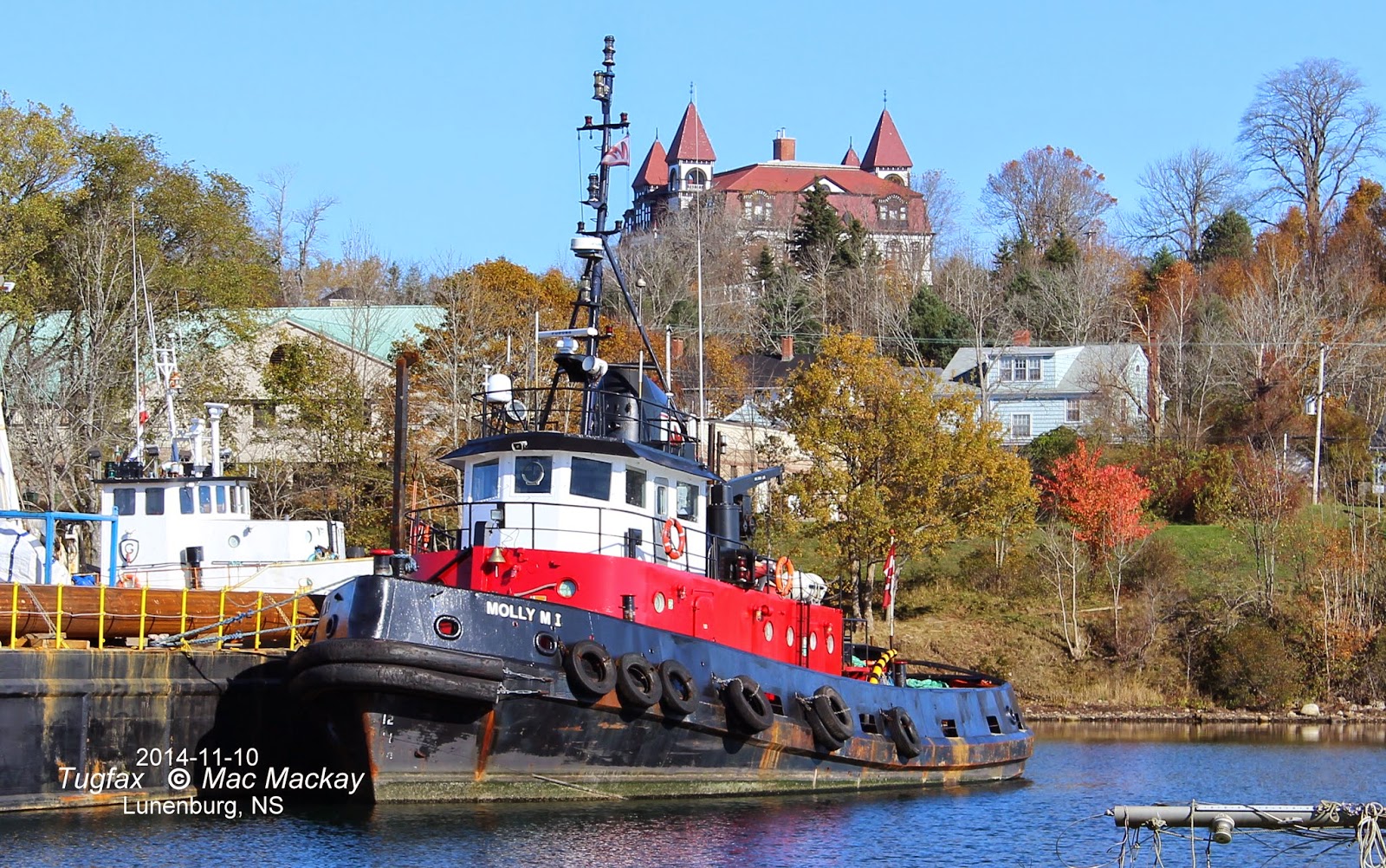The Anchor Handling Tug Supplier
Maersk Gabarus sailed from St.John's, NL, on October 4 [TO BE CONFIRMED] for an appointment with the shipbreakers in Gent, Belgium
Maersk Gabarus in the Narrows of Halifax harbour en route to Bedford Basin for trials.
Thanks to Dean Porter's blog for bringing this news to our attention.
Husky Oil Marketing Ltd and Bow Valley Resource Services Ltd, ushered in a new age of sophisticated and large offshore boats for Canadian waters when they ordered six new suppliers. Previously offshore work in Atlantic Canada was carried out by older US built boats, or European boats, designed for the North Sea or some relatively small Canadian craft.
These six boats, delivered in 1983 were purpose designed by the Vancouver firm of Cleaver & Walkingshaw* for work off Nova Scotia and Newfoundland.
Four of the boats were built by Hyundai Heavy Industries of Ulsan, North Korea and two were built in Canada. The Canadian built pair, from Bel-Aire Shipyard in North Vancouver, and Vito Steel Boats in Delta, BC, were different in detail but otherwise sisters, and all featured a distinctive hull form and highly geometric bridge. To say that they are unique is an understatement.
Maersk Gabarus was one of the Hyundai group and as
Gabarus Bay** arrived in Halifax July 25, 1983 for the first time. Two other Hyundai sisters,
Chignecto Bay and
Mahone Bay arrived here December 27, 1983 together towing the jack-up rig
Rowan Gorilla 3 from the Gulf of Mexico. The last in the group,
Trinity Bay arrived around December 31, 1983.
The Canadian pair
Placentia Bay (Bel-Aire) and
Bonavista Bay (Vito) had already arrived together June 23, 1983.
When Husky Bow Valley went on to to other things, the boats were put up for sale and in a surprise move A.P.Moller swept them up en bloc in 1988, and established themselves in St.John's as The Maersk Co Canada Ltd, since becoming Maersk Supply Service Canada Ltd. Maersk renamed all the boats by simply adding "Maersk" and subtracting "Bay" .
Maersk had just taken over the Husky boats, renamed them, and painted Maersk funnel marks when I took this slide in St.John's, NL March 15, 1988.That is Maersk Chignecto outobard of Maersk Gabarus.They still have their unique Husky Bow Valley hull colours.
At about 2770 grt and powered by four MaKs totaling 10,800 bhp, the boats developed 125 tonnes bollard pull, and were fully fitted for anchor handling, towing and supply work.
Over the years their paths began to diverge:
- Maersk Bonavista:2007: Drive Bonavista (Norway) reported in Bengal Bay June 2014
- Maersk Chignecto: still operating out of St.John's
- Maersk Mahone: 1987: Maersk Supporter, 1998:Maersk Handler, 2002: Maersk Trinity, 2005: Misr Gulf VII, 2006: Anchorman, 2008: Ocean Supporter - last reported in Turkey (St.Kitts + Nevis flag)
- Maersk Placentia: 1990: Maersk Shipper, 1997: Maersk Placentia, still operating out of St.John's.
- MaerskTrinity:1987:Maersk Server 1999: Maersk Helper, 2002: Maersk Mahone, 2014: Drive Mahone (Norway) last reported at Port Said, Egypt, September 2014.
On December 27, 2004, while working off Nova Scotia,
Maersk Gabarus was struck by a storm, which smashed windows and flooded the bridge. It made Halifax safely and was repaired.
Maersk Gabarus ex
Gabarus Bay is the first of the boats to go for breaking up. It is due in Gent on October 14. It is replaced in St.John's by Maersk's latest new vessel
Maersk Clipper a 6,490 grt behemoth with 15,000 bhp and 150 tonnes bollard pull. For more on her watch Dean's blog:
http://wwwshipshots.blogspot.ca/.
* Cleaver and Walkingshaw of Vancouver (formerly Jackson, Talbot, Walkingshaw, designers of Ocean Echo II and barges) were responsible for the design of the Canmar tug/suppliers and Arctic Transportation Ltd tug/suppliers. They became Polar Design Associates and were absorbed by Wartsila Artic, which evolved into Wartsila Marine, Kvaerner Masa Marine, Aker Yards Marine and STX Marine - designers of the CCG's new polar icebreaker and the RCN's Arctic Offshore vessels. It was announced this summer that they have now become Vard Marine Inc (a Fincantieri company).
** Gabarus Bay, on Cape Breton Island's east coast is pronounced Ga-Ba-ROOSE (rhymes with Goose).
.


































































.jpg)







